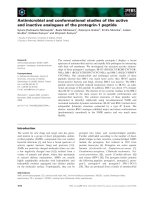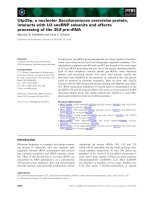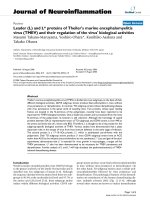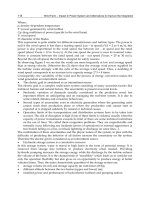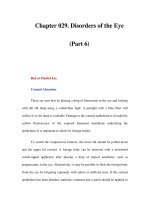Chapter 091. Benign and Malignant Diseases of the Prostate (Part 6) docx
Bạn đang xem bản rút gọn của tài liệu. Xem và tải ngay bản đầy đủ của tài liệu tại đây (13.08 KB, 5 trang )
Chapter 091. Benign and Malignant
Diseases of the Prostate
(Part 6)
Radical Prostatectomy
The goal of radical prostatectomy is to excise the cancer completely with a
clear margin, to maintain continence by preserving the external sphincter, and to
preserve potency by preserving the autonomic nerves in the neurovascular bundle.
Radical prostatectomy is advised for patients with a life expectancy of >10 years
and is performed using a retropubic, perineal, or laparoscopic approach. Outcomes
can be predicted using postoperative nomograms that consider pretreatment
factors and the pathologic findings at surgery. PSA failure is defined as a value
above 0.2 or 0.4 ng/mL, although the exact definition varies among series.
There is controversy over the definition of what constitutes "high risk"
based on a predicted probability of success or failure. In these situations,
nomograms and predictive models can only go so far. Exactly what probability of
success or failure would lead a physician to recommend and a patient to seek
alternative approaches is controversial. For example, it may be appropriate to
recommend radical surgery for a younger patient with a low probability of cure.
Prostatectomy techniques continue to improve as the ability to determine
whether the tumor is localized to the gland improves based on different biopsy
algorithms and with imaging. The result is better case selection and better surgical
planning, which in turn have led to more rapid recovery and higher rates of
continence and potency. Factors associated with incontinence include older age
and shorter urethra length. The specific surgical technique, open vs. laparoscopic
vs. robotic, as well as the skill and experience of the surgeon are also factors for
the preservation of neurovascular bundles and development of an anastomotic
stricture. Surgical experience is also a factor. In a series treated at an academic
center, 6% of patients had mild stress urinary incontinence (SUI) (requiring 1
pad/day), 2% moderate SUI (>1 pad/day), and 0.3% severe SUI (requiring an
artificial urinary sphincter). At 1 year, 92% were completely continent. In contrast,
the results in a Medicare population treated at multiple centers showed that at 3,
12, and 24 months following surgery, 58, 35, and 42% (respectively) wore pads in
their underwear, and 24, 11, and 15% reported "a lot" of urine leakage.
Factors associated with recovery of erectile function include younger age,
quality of erections before surgery, and the absence of damage to the
neurovascular bundles. Erectile function returns in a median of 4–6 months if both
bundles are preserved. Potency is reduced by half if at least one nerve bundle is
sacrificed. In cases where cancer control requires the removal of both bundles,
sural nerve grafts are being explored. Overall, with the availability of drugs such
as sildenafil, intraurethral inserts of alprostadil, and intracavernosal injections of
vasodilators, many patients recover satisfactory sexual function.
Neoadjuvant hormonal therapy has been explored in an attempt to improve
the outcomes of surgery for high-risk patients. The results of several large trials
testing 3 or 8 months of androgen depletion before surgery showed that serum
PSA levels decreased by 96%, prostate volumes decreased by 34%, and margin
positivity rates decreased from 41 to 17%. Unfortunately, hormones did not
produce an improvement in PSA relapse–free survival. Thus, neoadjuvant
hormonal therapy is not recommended.
Radiation Therapy
Radiation therapy is given by external beam, by radioactive sources
implanted into the gland, or by a combination.
External Beam Radiation Therapy
Contemporary external beam radiation techniques now use three-
dimensional conformal treatment plans with intensity-modulated radiation therapy
(IMRT) to maximize the dose to the prostate and to minimize the exposure of the
surrounding normal structures. The addition of IMRT has permitted further
shaping of the dose, allowing the delivery of still higher doses to the prostate and a
further reduction in normal tissue exposure. These advances have enabled the safe
administration of doses >80 Gy, higher local control rates, and fewer side effects.
Cancer control after radiation therapy has been defined by various criteria,
including a decline in PSA to <0.5 or 1 ng/mL, "nonrising" PSA values, and a
negative biopsy of the prostate 2 years after completion of treatment. PSA relapse
is defined as three consecutive rising PSA values from the nadir value, with the
time to failure as a rise by 2 ng/mL or greater above the posttreatment nadir value.
Radiation dose is important. A PSA nadir of <1.0 ng/mL was observed in
90% of patients receiving 75.6 or 81.0 Gy vs. 76 and 56% of those receiving 70.2
Gy and 64.8 Gy, respectively. The positive biopsy rates at 2.5 years were 4% for
those treated with 81 Gy vs. 27 and 36% for those receiving 75.6 or 70.2 Gy. The
frequency of rectal complications relates directly to the volume of the anterior
rectal wall receiving full-dose treatment.
Overall, radiation therapy is associated with a higher frequency of bowel
complications (mainly diarrhea and proctitis) than surgery. Grade 3 rectal or
urinary toxicities were seen in 2.1% of patients who received a median dose of
75.6 Gy. Grade 3 urethral strictures requiring dilatation developed in 1% of cases,
all of whom had undergone a transurethral resection of the prostate (TURP).
Pooled data show that the frequency of grade 3 and 4 toxicities is 6.9 and 3.5%,
respectively, for patients who received >70 Gy. The frequency of erectile
dysfunction is related to the quality of erections pretreatment, the dose
administered, and the time of assessment. Postradiation erectile dysfunction is
related to a disruption of the vascular supply and not the nerve fibers.
Neoadjuvant hormone therapy has also been studied in combination with
radiation therapy. The aim is to decrease the size of the prostate and, consequently,
to reduce the exposure of normal tissues to full-dose radiation, to increase local
control rates, and to decrease the rate of systemic failure. Short-term hormone
therapy can reduce toxicities and improve local control rates, but long-term
treatment (2–3 years) is needed to prolong the time to PSA failure and lower the
risk of metastatic disease. The impact on survival has been less clear.



